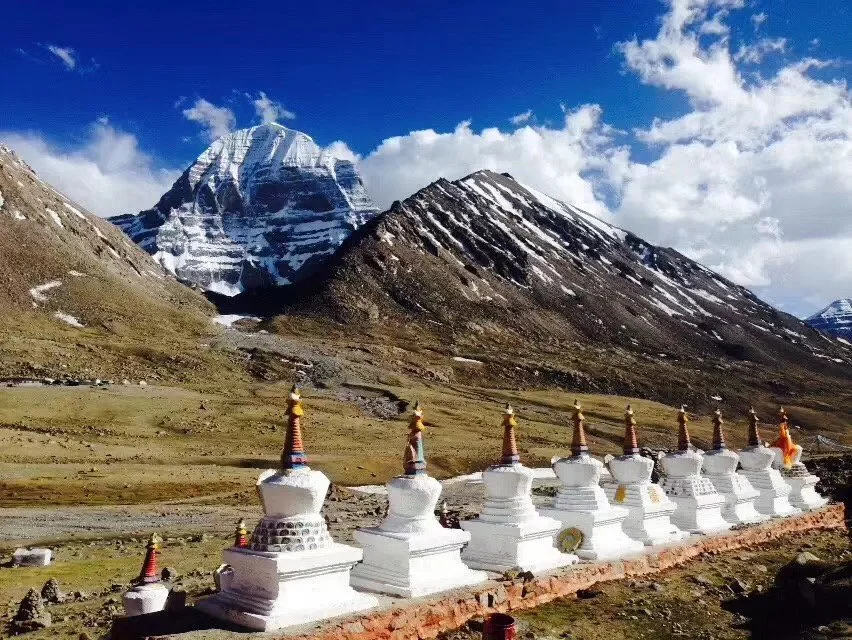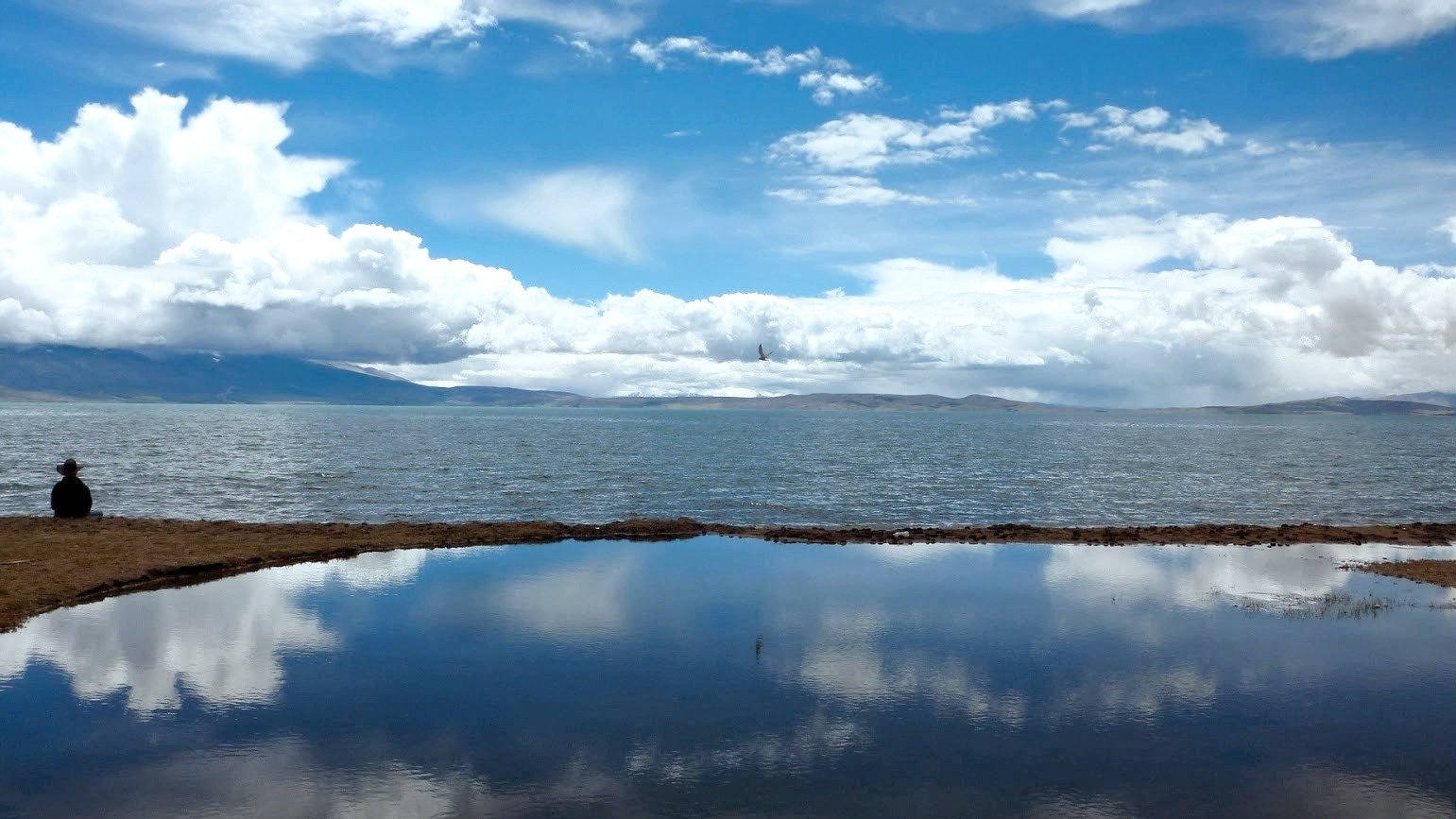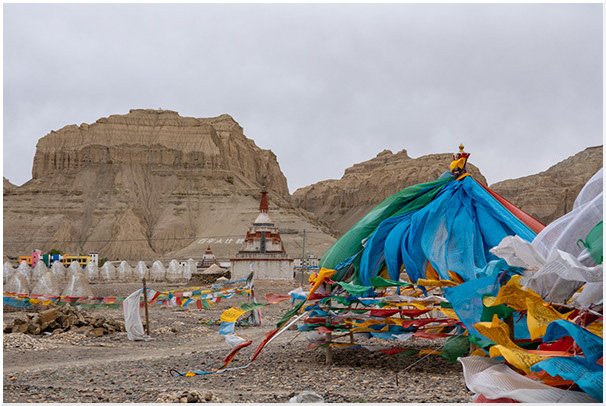Lhasa, New Everest Base Camp, Kailash & Guge Kingdom
15 Days (options to shorten or lengthen)
Enquire about this Small Group Tour
Mt. Kailash in Far-Western Tibet is always an unforgettable experience. It is one of the highest places in the world and the watershed of the mighty rivers of Asia. Mt Kailash is revered by millions—Hindus, Buddhists, Jains, Bonpos, and others—for its cosmic powers. After four days in Lhasa, you will go directly to Kailash or visit the New Mt Everest Base Camp on the way. At Kailash, you can hire a porter or a small Tibetan horse to help you walk the three-day circuit around the mountain. Then, you can extend for 2-3 days for the Kingdom of Guge or return to Lhasa or Shigatse.
Download this itinerary.
DAY 1: Arrive in Lhasa by plane or train, transfer to your hotel, and relax. The holy city of Lhasa was founded as the capital of the Tibetan Empire in the 7th century by Emperor Songtsen Gampo. Since the beginning of the ascendancy of the Dalai Lamas in the 17th century, it has had no rivals on the Tibetan Plateau. "The Place of the Gods" (10 950 ft.), which straddles the Kyichu Valley, is the planet's majestic rooftop city, where amid temples, wafting incense, and devoted Buddhists, the Tibetan culture continues. Filled with sights, sounds, and many shops, restaurants, and historical monasteries, the Tibetan quarter of Lhasa will keep you busy!
DAY 2: Visit the Jokhang Temple and the Barkhor in the morning and the nearby Sera Monastery in the afternoon. The Jokhang was built in the 7th century by King Songtsen Gampo and his two wives—the Nepalese Princess Bhrikuti and the Chinese Princess Wencheng. It houses the famous Jowo Rinpoche (Buddha Shakyamuni) statue, the holiest object in Tibet. Over the centuries, the complex has expanded and been rebuilt several times, but remarkably, the core of the original temple remains and can be visited. The Jokhang is a UNESCO World Heritage site, and its importance to the Tibetan people cannot be exaggerated.
DAY 3: Visit the Potala Palace in the morning and Norbulingka or Drepung Monastery in the afternoon.
The Potala, truly an architectural gem, was the residence of the Dalai Lamas, known to the Tibetans as Yishin Norbu, Wish-Fulfilling Gem. Emperor Songtsen Gampo is believed to have built the first palace in 637; it was rebuilt and expanded by the Great Fifth Dalai Lama in the 17th century. Today the Potala is a state museum, but the vibration of its sanctity can still be felt.
Drepung, or Rice Heap Monastery, located at the foot of Mount Gephel, is one of Tibet's most significant Gelukpa institutions. (The others are Ganden and Sera.) Drepung is about 8 km west of Lhasa and is built below a valley wall. It once housed more than 7,000 monks. Unfortunately, much has been destroyed, but the four primary buildings have been preserved.
The Norbulingka was developed in the mid-18th century as the Summer Palace of the Dalai Lamas. It was also the seat of government during the summer months. The complex includes a debating courtyard and three palaces. To the east, there is an open-air stage and gardens where operatic performances are held during the Shoton Festival.
DAY 4 (380 km): Leaving the city of Lhasa, you will drive along the scenic Kyichu River and cross the highest river in the world—the Tsangpo River, which becomes the Brahmaputra in India. After climbing a scenic and thrilling high pass, you'll arrive at Yamdrok Yutso Turquoise Lake.
This sacred lake sits at 4,408 m/14,461 ft and is believed to be the soul of the Tibetan nation. Stretching over an area of 754 km, its teal blue waters create the largest lake in southern Tibet. Surrounded by snow-capped mountain ranges, the lake is fed by icy streams and inlets that flow down from the higher elevations during the warm summer months. Its curved pincer shape boasts nine islands and numerous bays and is home to several monasteries. At Gampa La Pass, on the winding road that leads to Yamdrok Yutso Lake, you'll see an unforgettable vista of shimmering turquoise beneath a backdrop of glaciers.
In the afternoon, you will reach Gyantse to visit Kubum Stupa and Pelkor Monastery. Kubum Stupa is one of Tibet's most outstanding artistic achievements. Built in the 15th century, the Kumbum or gomang—many doored—stupa is 35 m tall, with nine gates and nine stories, and contains 75 chapels. Built as a three-dimensional mandala representing the universe, its circle within a square design is meant to aid an individual on the path to enlightenment. It contains important 14th-century murals and images. A good hotel awaits you in the City of Shigatse in the evening.
DAY 5: Leaving Shigatse, you will drive to the new Mount Everest Base Camp (EBC) at Rongbuk Monastery, the highest monastery in the world, rebuilt after the Cultural Revolution but still a very simple site. You will have the day to experience Everest and visit Rongbuk Monastery. Lodgings will be a campsite or a guesthouse.
Day 6 (360 km): Waking up early, you will enjoy the sunrise over Mt. Everest before leaving for a day-long drive to Saga. Along the way, you will enjoy spectacular views of Mount Shishapangma and the turquoise Pigutso Lake. Hotel or guesthouse in Saga.
DAY 7 (490 km): Driving to Mount Kailash, your next destination is the small village of Darchen (4,575 m) at the foot of the mountain. On the way, you will stop at Lake Manasarovar. It lies at 15,015 ft. and is the world's highest freshwater lake. At times, stretching to 55 miles in perimeter with a depth of 300 ft., the lake covers an area of 120 sq. miles. The Tibetan names for this lake are Mapham Yutso and Tso Madropa. It is one of two twin lakes, the other being Rakshas Tal. Together they are the sun and the moon. Hotel or guesthouse in Darchen.
Day 8 (20 km): From the Buddhist perspective, the walk or hike around Mt. Kailash is called kora. The trail winds around the mountain's base through barren lands and lush green valleys, offering views of snow-capped peaks and pristine blue lakes. There are a few monasteries to visit along the way and tent tea houses. The complete circuit requires three days for a distance of 53 km. In Darchen, you can hire a horseman and his horse if you wish and/or a porter to carry your backpack.
From Darchen, it's 8 km to Darboche (4,660 m). You can take a local bus. From Darboche, it's 12 km to the grassy meadows of Drirapuk Monastery (4,920 m), Cave of the Female Yak Hor. Drirapuk offers a spectacular view of the great north face, a vertical sheer cliff of jet-black rock. You will stay overnight in a guest house and enjoy the stunning Kailash towering above and close by.
Day 9 (18 km): Today, you will cross Dolma Pass, the highest pass in your trip. 6.4 km from Drirapuk. The ascent takes about four hours and is the most arduous part of the circuit. You set out early in the morning. The peak of Mount Kailash will now rise to your right. The trail meanders and passes a charnel ground where pilgrims discard an item of their possessions, representing their renouncement of worldly attachments. At the Pass, there is a large boulder into which the Twenty-One Taras (female buddhas) are said to have dissolved when the great Buddhist yogi Gotsangpo journeyed there. After Dolma Pass, you will gradually descend into the fields of Dzutrulpuk Monastery, where you will find another night's accommodations in a simple guesthouse and explore a famous Milarepa Cave the following morning.
Day 10 (14 km): This morning, the trail winds back to Darchen, and the walking circuit around Kailash is completed! Rest and enjoy your success. Hotel or guesthouse. In the afternoon, we will drive to Zhada in the Kingdom of Guge. (245 km) Founded in the 10th century by a descendant of a Tibetan king, its emergence marked the second promulgation of Buddhism in Tibet. Lost in the 17th century under mysterious circumstances, it was rediscovered in the 1930s by the Italian explorer Guiseppe Tucci. The area includes houses, once-inhabited caves, monasteries, and stupas, as well as sculptures, carvings, and murals. The ruins cover an area of 720,000 square meters and lie at 3,800 m/12,400 ft. Nice Guesthouse
Day 11 (260 km) Visit Guge and Tholing. Then drive to the far shore of Manasarovar Lake. The Lake's surface reflects Mt. Kailash most of the year except in winter when it freezes over. Revered as the epitome of purity, these waters are believed to have healing properties, physical and spiritual. Religious Hindus can be seen performing their ablutions. Very poor Guesthouse.
Day 12 (520 km): Return to Saga. Hotel.
Day 13 (470 km): Drive to Shigatse. Hotel.
Day 14 (280 km): Visit Tashilhunpo Monastery, founded by the First Dalai Lama in 1447 and one of the most important religious institutions in Tibet. Then, drive back to Lhasa and have a few hours for last-minute shopping or restaurants in Lhasa. 4-Star Hotel. Or exit to the Nepal border.
Day 15: Leave Tibet from Lhasa by plane or train or extend your visit. Or leave from Shigatse airport.
OPTIONS:
Can be shortened by omitting Mt. Everest Base Camp and/or Guge.





